
Clarkia davyi is a species of flowering plant in the evening primrose family known by the common name Davy's fairyfan, or Davy's clarkia. It is endemic to California, where it grows in coastal habitats such as beaches and bluffs. This is an annual herb producing a thin stem which grows along the ground or somewhat upright. It is lined with small oval-shaped leaves one or two centimeters long. While in bud the flower is enclosed in four fused thick sepals. It blooms into a petite bowl-shaped corolla of four pink petals which often have lighter bases. Each petal is 5 to 11 millimeters long.

Chylismia cardiophylla is a species of evening primrose known by the common name heartleaf suncup. It is native to the deserts of northwestern Mexico and the southwestern United States, where it grows in sandy and rocky areas in the desert scrub. It is an annual or perennial herb approaching one meter in maximum height, taking the form of a single erect stem or a low bushy plant. The leaves are up to about 5 centimeters long and are oval or roughly heart-shaped, with rippling or dully toothed edges. The nodding inflorescence is a dense bunch of flowers, each individual cup-shaped bloom on a stout pedicel. The flowers are yellow or cream-colored with petals 3 to 12 millimeters long, and generally remain closed during the day. The fruit is a capsule 2 to 5 centimeters long.

Camissonia contorta is a species of evening primrose known by the common name plains evening primrose. It is native to western North America from British Columbia to California to Idaho, where it grows in many habitat types. It is an annual herb producing a slender, bending to curling red or green stem which is sometimes hairy. It is up to 30 centimeters long and erect or spreading out. The blue-green leaves are linear to very narrowly oval in shape and up to 3.5 centimeters long. The nodding inflorescence produces one or more small flowers. Each has bright yellow petals up to half a centimeter long, sometimes with small red dots near the bases. The fruit is a capsule about 3 centimeters long containing shiny seeds.
Chylismia heterochroma is a species of evening primrose known by the common name Shockley's evening primrose. It is native to the desert slopes and woodland of eastern California and Nevada. It is a hairy, glandular annual herb growing a spindly stem up to a meter tall. There is a thick basal rosette of leaves which are mostly oval in shape and several centimeters in length, and generally no leaves higher up the stem. The inflorescence produces several small flowers with four oval petals just a few millimeters long and lavender in color with yellow-tinted bases. The fruit is a club-shaped capsule roughly a centimeter long.
Camissoniopsis intermedia is a species of evening primrose known by the common name intermediate suncup. It is native to California and Baja California, where it grows on the slopes of coastal and inland hills and mountains, especially in areas that have recently burned. It is an annual herb producing an erect, hairy stem up to about half a meter in height. Most of the leaves are located in a basal rosette at ground level and are oval to lance-shaped and up to 12 centimeters in length. The hairy, nodding inflorescence produces flowers with yellow petals just a few millimeters in length. The petals have one or two red dots at their bases. The fruit is a straight or coiling, wormlike capsule up to 2.5 centimeters long.
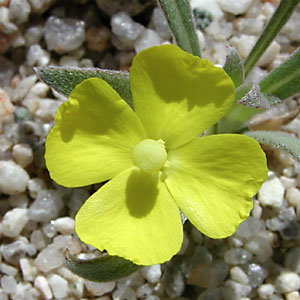
Camissoniopsis pallida is a low growing, yellow-flowered annual plant in the evening primrose family, Onagraceae. It is known by the common names pale primrose or pale yellow suncup. It is native to the desert and scrub habitat of the region where Arizona, California, and Nevada meet. It is a roughly hairy annual herb growing in a low patch on the ground, sometimes producing an erect stem from the basal rosette. The herbage is gray-green to reddish green. The leaves are lance-shaped and up to 3 centimeters long. The nodding inflorescence produces flowers with yellow petals 2 to 13 millimeters long, each with small red markings near the bases. The fruit is a straight to tightly coiled capsule.
Camissonia pusilla is a species of evening primrose known by the common name little wiry suncup. It is native to the western United States from California to Idaho, where it grows in sagebrush and other habitat. It is a petite, hairy, glandular annual herb producing very slender erect stems up to about 22 centimeters in maximum height. The leaves linear with toothed edges and 1 to 3 centimeters long. The nodding inflorescence produces flowers with yellow petals 2 or 3 millimeters long and usually spotted with red near the bases. The fruit is a straight or coiling capsule up to 3 centimeters long.
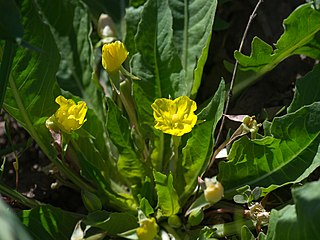
Taraxia subacaulis is a species of evening primrose known by the common name diffuseflower evening primrose. It is native to the western United States, where it grows in several habitat types, especially in mountainous areas. It is a fleshy perennial herb growing from a taproot and usually lacking a stem. The leaves are lance-shaped to oval and up to 22 centimeters long and are borne on long petioles. The flower has yellow petals, each up to 1.5 centimeters long, and a large, bulbous stigma tip. The fruit is a leathery capsule 1 to 3 centimeters long.
Clarkia australis is a species of flowering plant in the evening primrose family known by the common name Small's southern clarkia. It is endemic to California, where it grows in the forests of the central Sierra Nevada. It is an uncommon species threatened by such forest activities as logging. This annual herb produces a slender, erect stem approaching a meter in height. The leaves are widely linear in shape and borne on short petioles. The top of the stem is occupied by the tall inflorescence, which bears hanging buds that open from the lowest upward so that there are several closed buds above open flowers. The sepals do not remain fused as the flower opens. The petals are diamond-shaped and sometimes lobed and curling at the tip. They are mottled or spotted lavender, purple, and reddish in color, and each is up to 1.5 centimeters long. There are 8 long stamens tipped with large anthers bearing blue-gray pollen. The stigma protrudes past the anthers.
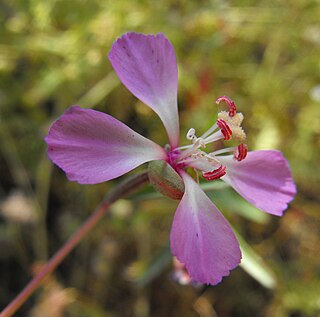
Clarkia delicata is a rare species of flowering plant in the evening primrose family known by the common names Campo clarkia and delicate clarkia. It is native to northern Baja California and adjacent San Diego County, California, where it grows in the woodland and chaparral of the Peninsular Ranges. This is an annual herb producing an erect stem just over half a meter in maximum height. The leaves are oval or widely lance-shaped, up to 4 centimeters long, and borne on very short petioles. The top of the stem is occupied by the inflorescence, in which the lower flowers open while the upper buds hang closed. The sepals remain fused as the flower blooms from one side. Each unlobed oval petal is about a centimeter long and pink to pinkish-lavender. There are 8 stamens, some with large orange anthers and some with smaller, paler anthers. There is also a protruding stigma with four large, fuzzy lobes.

Clarkia franciscana is a rare species of flowering plant in the evening primrose family known by the common name Presidio clarkia. It is endemic to the San Francisco Bay Area of California, where it is known only from two populations at the Presidio of San Francisco and three occurrences in Oakland. The plant is known only from serpentine soils.
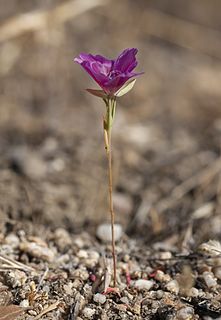
Clarkia jolonensis is an uncommon species of flowering plant in the evening primrose family known by the common name Jolon clarkia. It is endemic to Monterey County, California, where it is known from the woodlands of the Central Coast Ranges.

Clarkia mildrediae is an uncommon species of flowering plant in the evening primrose family known by the common name Mildred's clarkia. It is endemic to California, where it is known from the forests of the southernmost Cascade Range and northern Sierra Nevada. It is an erect annual herb often exceeding half a meter in height. The oval leaves grow up to 6 centimeters long and are borne on petioles of up to 4 centimeters. The inflorescence bears opening flowers and hanging, pointed flower buds. As the bud opens the sepals all separate instead of remaining fused as those of many other Clarkia species do. The triangular to semicircular petals are about 2 centimeters long and lavender to bright reddish-purple, sometimes with dark speckling. There are 8 stamens with anthers all alike, and a protruding stigma.
Clarkia prostrata is a species of flowering plant in the evening primrose family known by the common name prostrate clarkia. It is endemic to the coastline of San Luis Obispo County, California, where it grows on seaside bluffs in forested and grassy areas. This annual herb is prostrate as opposed to erect as most other Clarkia species are. Its stems extend to a maximum length approaching half a meter and are usually somewhat fuzzy in texture. The leaves are oval in shape, up to 2.5 centimeters long, and lack petioles. The sepals of the flower separate into two pairs, revealing the lavender-pink blooming petals. Each petal is just over a centimeter long, fan-shaped to oval, and sometimes with a yellow base marked with a red spot.
Epilobium foliosum is a species of flowering plant in the evening primrose family known by the common names leafy willowherb and California willowherb. It is native to parts of western North America from British Columbia through California to Arizona, where it grows in many types of habitat, including disturbed areas.

Epilobium oreganum is an uncommon species of flowering plant in the evening primrose family known by the common names Grants Pass willowherb and Oregon fireweed. It is native to southern Oregon and northern California, where it is historically known mostly from the Klamath Mountains. It is currently confirmed to exist only in Josephine County, Oregon, and Trinity County, California, where it grows in boggy areas on serpentine soils. It is a perennial herb growing up to a meter in height with thin, hairless stems. The red-veined leaves are oval to lance-shaped and up to 9 centimeters long. The inflorescence bears flowers with pink petals just over a centimeter long and a protruding pistil. The fruit is a hairy, glandular capsule up to 4.5 centimeters long.
Monardella palmeri is a species of flowering plant in the mint family known by the common name Palmer's monardella.

Oenothera wolfii is a rare species of flowering plant in the evening primrose family known by the common name Wolf's evening primrose. It is native to the coastline of southern Oregon and northern California, where it grows in coastal prairie, dunes, and coastal forest and woodland habitat. As of 1997 it was known from only about 16 occurrences. The biggest threat to the plant is its easy hybridization with its relative and probable descendant, Oenothera glazioviana. As this rare wild plant crosses with the introduced garden escapee, introgression occurs, causing what is known as genetic pollution; fewer pure individuals of O. wolfii will be seen as they are outnumbered by hybrids.
Primula capillaris is a rare species of flowering plant in the primrose family known by the common name Ruby Mountains primrose, or Ruby Mountain primrose. It is endemic to Nevada in the United States, where it is limited to the Ruby Mountains of Elko County.
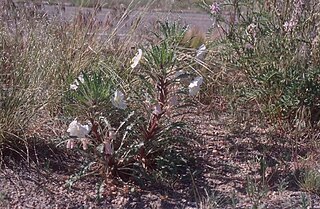
Oenothera harringtonii is a species of flowering plant in the evening primrose family known by the common names Arkansas Valley evening primrose and Colorado Springs evening primrose. It is endemic to the state of Colorado in the United States.












